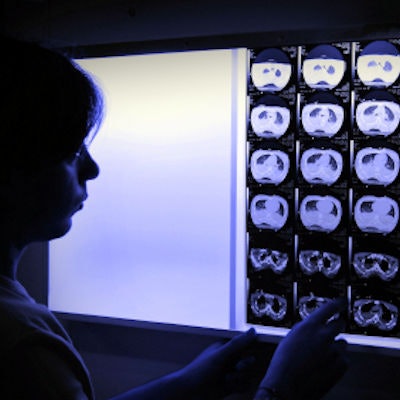
Female radiologists interpret fewer advanced imaging studies than their male counterparts, according to a study published online July 4 in Academic Radiology.
This kind of "horizontal segregation" -- the disparity between genders in this distribution of responsibilities -- may have a negative impact on women in the field, discouraging them from seeking careers in radiology and affecting their compensation, promotion, and career advancement opportunities, wrote a team led by Dr. Gelareh Sadigh of Emory University School of Medicine in Atlanta.
"In radiology, one could hypothesize that a source of horizontal occupational segregation could be differences between genders in the interpretation of different modalities (i.e., the relative distribution of a radiologist's clinical work effort among basic versus advanced modalities)," the group wrote. "Given the potential far-reaching impact of clinical practice patterns on compensation, promotion, prestige, and status within a practice, as well as collaboration and research opportunities, any such differences would be important to recognize."
Distribution of labor
The underrepresentation of women in the radiology workforce is receiving increased attention, but the distribution of tasks, labor, and responsibilities between genders is not, Sadigh and colleagues wrote. So, the group conducted an analysis to investigate the existence of horizontal workplace segregation in radiology as exhibited in differences in the distribution of clinical work among imaging modalities.
The study data came from the 2016 Medicare Physician and Other Supplier Public Use File and included 22,445 Medicare-participating general, neuro, abdominal, cardiothoracic, and musculoskeletal radiologists. The researchers stratified work effort in radiography, ultrasound, CT, and MRI by gender. Of the 22,445 radiologists, 19% were female; of these, 30.6% were in academic practices compared with 17.1% of male radiologists.
Of the women radiologists, the group found the following:
- 60.7% were generalists.
- 14.6% were neuroradiologists.
- 13.3% were abdominal radiologists.
- 6% were cardiothoracic radiologists.
- 5.4% were musculoskeletal radiologists.
Sadigh and colleagues found that being female was associated with lower work effort in advanced imaging modalities such as CT and MRI, although results were not statistically significant across all types of radiologists.
| Percentage work effort across imaging modalities by gender | ||||
| Type of radiologist | X-ray | Ultrasound | CT | MRI |
| Generalist* | ||||
| Female | 23.3% | 11.4% | 55.1% | 10.2% |
| Male | 22% | 10.5% | 54.2% | 13.2% |
| Abdominal* | ||||
| Female | 11% | 27.1% | 52.7% | 8.1% |
| Male | 12.7% | 21.9% | 56% | 9.4% |
| Cardiothoracic | ||||
| Female | 63.5% | 2.2% | 33.5% | 0.8% |
| Male | 64.8% | 2.1% | 31.6% | 1.5% |
| Musculoskeletal* | ||||
| Female | 41.6% | 2.4% | 11.2% | 44.8% |
| Male | 34.8% | 2.8% | 12.8% | 49.6% |
| Neuroradiology | ||||
| Female | 7.1% | 2.4% | 43.1% | 47.4% |
| Male | 7.2% | 2.3% | 42.4% | 48.1% |
"Although not universally present, we did observe contexts in which women tend to have lower work effort in advanced imaging modalities," the group wrote. "The most pronounced variation was among academic abdominal radiologists, for which females had a considerable focus in their work effort on ultrasound, rather than CT and MRI. ... Awareness of any such variations in clinical practice patterns is important given potential downstream career implications."
Why the disparity?
The study did not uncover reasons for the disparity, Sadigh told AuntMinnie.com.
"We aren't sure if this disparity of work effort is due to women radiologists' preference or interest in certain imaging modalities -- which happen to be lower relative value units (RVU) -- or if it is the result of unconscious biases by employers or administrators," she said. "Whatever the reasons, it contributes to lower pay for women radiologists."
What can be done to mitigate horizontal occupational segregation? Recognizing it is the first step, Sadigh said.
"Studies such as ours are needed to first assess the existence of disparity and further studies on the reasons for it," she said. "As the radiology community continues to work on strategies to close gender gaps in radiology, it is important to identify different factors that may contribute to [the gaps] and address them. The more we talk about it, the better we can understand the problem."




















